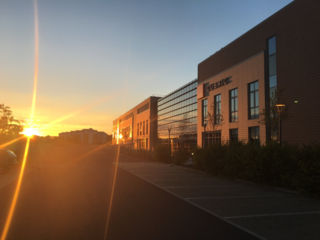The following outline is provided as an overview of and topical guide to neuroscience:
Neuroinformatics is the field that combines informatics and neuroscience. Neuroinformatics is related with neuroscience data and information processing by artificial neural networks. There are three main directions where neuroinformatics has to be applied:
The Blue Brain Project is a Swiss brain research initiative that aims to create a digital reconstruction of the mouse brain. The project was founded in May 2005 by the Brain and Mind Institute of École Polytechnique Fédérale de Lausanne (EPFL) in Switzerland. Its mission is to use biologically-detailed digital reconstructions and simulations of the mammalian brain to identify the fundamental principles of brain structure and function.
Brain mapping is a set of neuroscience techniques predicated on the mapping of (biological) quantities or properties onto spatial representations of the brain resulting in maps.
Connectomics is the production and study of connectomes: comprehensive maps of connections within an organism's nervous system. More generally, it can be thought of as the study of neuronal wiring diagrams with a focus on how structural connectivity, individual synapses, cellular morphology, and cellular ultrastructure contribute to the make up of a network. The nervous system is a network made of billions of connections and these connections are responsible for our thoughts, emotions, actions, memories, function and dysfunction. Therefore, the study of connectomics aims to advance our understanding of mental health and cognition by understanding how cells in the nervous system are connected and communicate. Because these structures are extremely complex, methods within this field use a high-throughput application of functional and structural neural imaging, most commonly magnetic resonance imaging (MRI), electron microscopy, and histological techniques in order to increase the speed, efficiency, and resolution of these nervous system maps. To date, tens of large scale datasets have been collected spanning the nervous system including the various areas of cortex, cerebellum, the retina, the peripheral nervous system and neuromuscular junctions.
The Human Brain Project (HBP) was a large ten-year scientific research project, based on exascale supercomputers, that aimed to build a collaborative ICT-based scientific research infrastructure to allow researchers across Europe to advance knowledge in the fields of neuroscience, computing, and brain-related medicine.

Tania Singer is a German psychologist and social neuroscientist and the scientific director of the Max Planck Society's Social Neuroscience Lab in Berlin, Germany. Between 2007 and 2010, she became the inaugural chair of social neuroscience and neuroeconomics at the University of Zurich and was the co-director of the Laboratory for Social and Neural Systems Research in Zurich. Her research focuses on the developmental, neuronal, and hormonal mechanisms underlying human social behavior and social emotions such as compassion and empathy. She is founder and principal investigator of the ReSource project, one of the largest longitudinal studies on the effects of mental training on brain plasticity as well as mental and physical health, co-funded by the European Research Council. She also collaborates with the macro-economist Dennis Snower on research on caring economics. Singer's Caring Economics: Conversations on Altruism and Compassion, Between Scientists, Economists, and the Dalai Lama was published in 2015. She is the daughter of the neuroscientist Wolf Singer.

Angela Jane Roskams is a neuroscientist at the University of British Columbia (UBC) with a joint appointment in Neurosurgery at the University of Washington. She is professor at the Centre for Brain Health at UBC, and directed the laboratory of neural regeneration and brain repair, before winding down her lab in 2015–16 to become Executive Director of the Allen Institute for Brain Science, and a leader in the Open Science movement. After leading Strategy and Alliances for the Allen institute's multiple branches, she has become an influencer in the fields of neuroinformatics, public-private partnerships, and Open Data Sharing.
The following outline is provided as an overview of and topical guide to brain mapping:

The Neuroimaging Tools and Resources Collaboratory is a neuroimaging informatics knowledge environment for MR, PET/SPECT, CT, EEG/MEG, optical imaging, clinical neuroinformatics, imaging genomics, and computational neuroscience tools and resources.
The Bernstein Network is a research network in the field of computational neuroscience; this field brings together experimental approaches in neurobiology with theoretical models and computer simulations. It unites different scientific disciplines, such as physics, biology, mathematics, medical science, psychology, computer science, engineering and philosophy in the endeavor to understand how the brain functions. The close combination of neurobiological experiments with theoretical models and computer simulations allows scientists of the Bernstein Network to pursue innovative approaches with regard to one of the most complex structures nature has created in the course of evolution: the natural brain.
Randy L. Buckner is an American neuroscientist and psychologist whose research focuses on understanding how large-scale brain circuits support mental function and how dysfunction arises in illness.

OpenNeuro is an open-science neuroinformatics database storing datasets from human brain imaging research studies.
Sean Lewis Hill is an American neuroscientist, Professor at the University of Toronto Faculty of Medicine, and inaugural Scientific Director of the Krembil Centre for Neuroinformatics in Toronto, Canada. He is also co-director of the Blue Brain Project at the École Polytechnique Fédérale de Lausanne located on the Campus Biotech in Geneva, Switzerland. He is known for the development of large-scale computational models of brain circuitry, neuroinformatics, and innovation in AI for mental health.
Viktor K. Jirsa is a German physicist and neuroscientist, director of research at the Centre national de la recherche scientifique (CNRS), director of the Institut de Neuroscience des Systèmes and co-director of the Fédération Hospitalo-Universitaire (FHU) EPINEXT "Epilepsy and Disorders of Neuronal Excitability" in Marseille, France. He is workpackage leader in the Epinov project funded in the context of the RHU3 call and coordinated by Fabrice Bartolomei.

The Cardiff University Brain Research Imaging Centre (CUBRIC) is a brain imaging centre, part of Cardiff University's Science and Innovation Campus in Cardiff, Wales, United Kingdom. When it expanded in 2016, it was considered the most advanced brain imaging centre in Europe.

NeuroVault is an open-science neuroinformatics online repository of brain statistical maps atlases and parcellations.

Dimitri Van De Ville is a Swiss and Belgian computer scientist and neuroscientist specialized in dynamical and network aspects of brain activity. He is a professor of bioengineering at EPFL and the head of the Medical Image Processing Laboratory at EPFL's School of Engineering.







